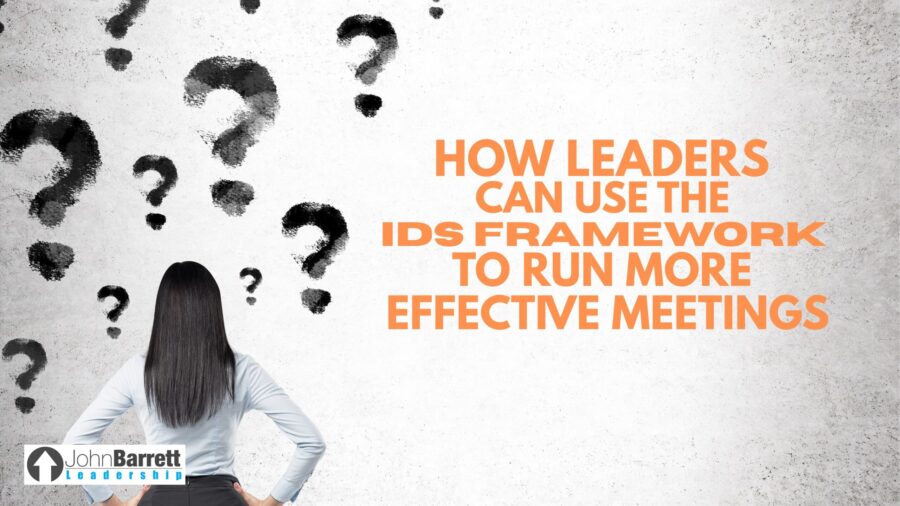How Leaders Can Use the IDS Framework to Run More Effective Meetings
One of the most frustrating things in leadership is sitting through meetings that go in circles—discussions that never get to the real problem, and conversations that lack direction or resolution. That’s where the IDS framework—Identify, Discuss, Solve— comes in. This simple but excellent system, made famous by Gino Wickman’s Traction (side note: every leader should read that book), is designed to help leaders streamline their decision-making process and drive productive outcomes.
By implementing the IDS framework, leaders can turn unproductive discussions into action-oriented problem-solving sessions that move teams forward. Let’s break it down.
Step 1: Identify the Right Issues
The first step in IDS is to identify the real issues. This means taking time to clarify what’s actually worth discussing. Too often, teams spend time on surface-level frustrations or the wrong problems entirely. The key is to ensure that the issues being addressed are relevant, significant, and agreed upon by the group.
Here’s a few tips for this phase:
- Choose high-impact problems. Not all issues deserve meeting time. Prioritize the ones that are holding the team back.
- Get agreement. The team should collectively acknowledge that this is a key issue worth solving…be collaborative.
- Clarify, don’t assume. Sometimes, what seems like the problem is just a symptom of something deeper.
Example:
A sales team is missing targets. At first pass, the problem seems to be “we need better sales training.” But after identifying and reviewing data, the real issue might be unclear messaging, poor lead qualifications, or an ineffective sales process altogether.
Step 2: Discuss to Find the Root Cause
Once an issue is identified, the next step is to discuss it. But this isn’t just about venting frustrations—it’s about getting to the root of the problem.
One of the biggest mistakes teams make is treating symptoms instead of solving the actual cause. Taiichi Ohno, in his Five Whys methodology, suggests asking “why” multiple times to drill down to the root of an issue.
Discussion tips:
- Dig deeper. Ask, “Why?” multiple times until you uncover the core issue.
- Encourage open, honest dialogue. Create a safe space for candid conversations.
- Avoid blame. Focus on finding solutions, not pointing fingers at people.
Example:
Returning to the sales team example, let’s say you discover that the problem isn’t a lack of training but rather a flawed sales script that isn’t resonating with customers. Now, instead of sending your team to another seminar, you focus on fixing the messaging.
As Charles Kettering famously said, “A problem well defined is half-solved.” The better your team discusses and understands an issue, the closer you are to a real solution.
Step 3: Solve with Clear, Actionable Steps
The final step is to solve the problem, meaning the team agrees on a clear resolution and next steps.
A great meeting doesn’t end with “we’ll think about it” or “let’s revisit this next time.” It ends with:
- A specific solution. What exactly needs to happen?
- An assigned owner. Who is responsible for executing the solution?
- A deadline. When will the solution be implemented?
Remember my process to ending meetings…The 3 Ws…WHO, does WHAT, by WHEN?
Example:
For the sales team, the solution might be to revise the sales script, test it with a small group of prospects, and adjust it based on feedback. The sales manager owns this task and has a two-week deadline to implement the changes.
A decision without execution is useless. Ensure every meeting concludes with real actions that will drive change.
Why IDS Will Make Your Meetings More Effective
When leaders embrace the IDS framework, meetings become focused, productive, and action-oriented. Instead of wasting time on circular conversations, teams walk away with real solutions and a plan to implement them.
Here’s what this framework will do for your team: Eliminate wasted time on minor or irrelevant issues
Drive deeper problem-solving by identifying the real root cause
Create accountability by ensuring clear solutions and ownership
Increase momentum by turning decisions into immediate action
At the end of the day, great leadership is about problem-solving, not just problem-talking. When you structure your meetings with IDS, you ensure your team isn’t just discussing problems but actively solving them.
So, next time you head into a meeting, ask yourself: Are we just talking about problems, or are we identifying, discussing, and solving them? The difference between a meeting that feels like a waste of time and one that drives real progress comes down to this simple framework.
Now go lead with clarity, confidence, and purpose! I am rooting for you!









